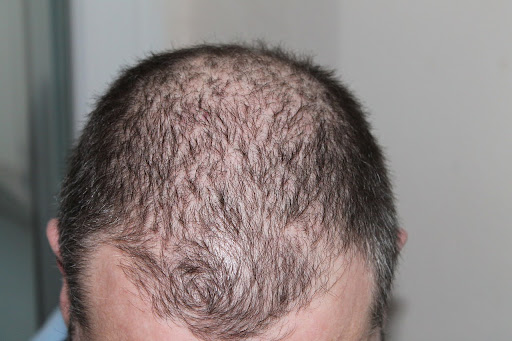Hair loss is a natural part of life for many people, but losing hair may be especially depressing for males. The most prevalent kind of hair loss is male pattern baldness, also known as androgenetic alopecia, which affects millions of men worldwide. While it cannot be totally avoided, understanding the reasons, phases, and treatment choices available may help you take charge of your hair health and find solutions that give you confidence. In this blog, we will discuss about losing hair, the causes and treatments.
What is Male Pattern Baldness?
Male pattern baldness, commonly known as androgenetic alopecia, is a hereditary common type of hair loss disorder that affects males.
Male pattern baldness is a progressive and predictable process, as opposed to rapid or uneven hair loss caused by stress, disease, or medicine. It normally follows a predictable pattern, beginning with a receding hairline at the temples and advancing to crown thinning.
These regions may eventually grow entirely bald, whereas the hair on the sides and back of the head stays comparatively undamaged.
How Do I Know If I’m Losing Hair?
Have you noticed extra hair in your shower drain or on your pillow? These are typical symptoms of hair loss. But how can you know if it’s just natural shedding or the beginnings of male pattern hair loss or baldness?
Look for the following warning signs:
- Gradual receding hairline at the temples
- Thinning on the crown of the head
- Widening of the part
- Increased hair shedding
- Miniaturization of hair follicles (hair becoming thinner and finer)
Causes of Male Pattern Baldness
Genetics: If your father or grandfather experienced hair loss, you’re more likely to experience it too. Specific genes influence how your hair follicles respond to male sex hormones, making them more susceptible to miniaturization.
Hormones: Androgens, primarily dihydrotestosterone (DHT), are the main culprits. DHT shrinks hair follicles over time, leading to progressive hair loss.
Stages of Male Pattern Baldness

The Norwood-Hamilton scale is a widely used system for classifying the stages of male pattern baldness:
Stage 1: Receding hairline with minimal thinning on the crown
Stage 2: Further receding hairline and slight thinning on the crown
Stage 3: Continued receding hairline and more noticeable thinning on the crown
Stage 4: Deepening baldness on the crown with a horseshoe-shaped pattern remaining
Stage 5: Significant baldness on the crown with only a thin rim of hair remaining
Stage 6: Further progression of baldness on the crown, leaving only a narrow band of hair
Stage 7: Almost complete baldness on the crown with only wispy hair remaining
Diagnosis and Tests
A visit to your doctor for a checkup is frequently the first step in diagnosing male pattern baldness. Doctors will examine your scalp for hair loss patterns and inquire about your family history.
They may also do a hair pull test, in which they gently tug on hairs to check how many readily fall out.
Your doctor may advise you to get blood tests to examine your iron levels, thyroid hormone levels, and testosterone levels. These can aid in the diagnosis of illnesses that produce excessive shedding, such as thyroid dysfunction.
A scalp biopsy may be performed in some situations by your doctor. This includes removing a tiny piece of skin from regions of hair loss with a punch instrument. A microscope is used to analyze the sample for symptoms of a fungal infection or other skin problems.
A doctor may generally identify male pattern baldness based on the appearance of miniaturized hairs in a balding pattern from your medical condition. As baldness progresses, the shrunken hairs grow thinner and shorter. A densitometer is an instrument that doctors may use to assess hair caliber and estimate the level of shrinkage.
While testing is occasionally required, a thorough history and physical examination are frequently enough to diagnose male pattern baldness. Doctors can see the common patterns of hair loss.
Treatment Options

Male pattern baldness can be treated with a variety of methods, with varying degrees of success.
Medications
Minoxidil and finasteride are the two major drugs used to treat male pattern baldness.
Minoxidil, when given topically to the scalp, stimulates hair growth. In some men, it delays additional hair loss, but only while therapy is continuing. Finasteride is administered orally as a tablet.
It works by inhibiting the DHT hormone, which causes hair loss. Finasteride results may take many months to manifest. It reduces further hair loss in most men and helps some men regrow hair. If the medication is discontinued, hair loss will return. To sustain results, both drugs must be taken indefinitely. They are not suitable for all males and will have side effects.
Laser Therapy
Low-level laser light therapy is a relatively recent therapeutic option for hair loss. For brief periods of time, little combs or caps containing laser beams are put on the scalp. The low-light therapy is intended to stimulate hair follicles and cell activity. While it shows some promise, additional study is required to validate its efficacy. The FDA has not authorized laser hair growth devices.
Hair Transplants
Hair transplantation is a surgical treatment that involves removing hair follicles from locations where hair loss is not present and implanting them in bald or thinning hair areas. Hair follicles that have been transplanted continue to develop normally in their new site.
A transplant, albeit costly and time-consuming, can produce natural-looking results. Patients must have enough donor hair on hand. Multiple procedures are frequently required. The two most frequent transplant methods are FUE (follicular unit extraction) and FUT (follicular unit transplantation).
Other Options
When natural oils are administered, microneedling causes microscopic incisions in the scalp that are supposed to accelerate healing and hair growth. However, greater proof of efficacy is required.
Scalp reduction eliminates bare skin and brings hair-bearing scalps together. The outcomes are just transient. Hairpieces and wigs can help with cosmetic concealment. Some people choose to shave their heads totally. Acceptance of hair loss may be the healthiest decision in the end.
Conclusion
Lastly, how to treat male pattern baldness is a personal choice. Some men decide to shave their heads and accept their baldness, while others prefer to investigate therapeutic alternatives to reduce or restore hair loss. There are no right or incorrect answers; the key thing is to select what makes you feel most secure and comfortable.
If you enjoyed this article, you may also want to read this article on How Do Chia Seeds Lower Testosterone?
*This information is not intended to serve as a substitute for professional medical or dietary advice tailored to individual needs.
Dr. Kimberly Langdon has been an MD for 31 years, board-certified obstetrician/gynecologist with 19-years of clinical experience. She graduated from The Ohio State University College of Medicine, earning Honors in many rotations. She then completed her OB/GYN residency program at The Ohio State University Medical Center, earning first-place accolades for her Senior Research Project and Score of 98th percentile on a National Proficiency Test.
During her clinical career, she delivered over 2000 babies and specialized in minimally invasive procedures, menopause, endometriosis, menstrual disorders, and polycystic ovarian syndrome. After retiring from clinical practice, she founded a medical device company to commercialize her two patented and four patent-pending medical devices for both life-threatening and non-life-threatening infections.




